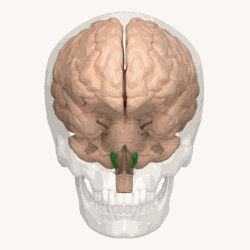Loading AI tools
From Wikipedia, the free encyclopedia
The olivary bodies or simply olives (Latin oliva and olivae, singular and plural, respectively) are a pair of prominent oval structures on either side of the medullary pyramids in the medulla, the lower portion of the brainstem. They contain the olivary nuclei.
| Olivary body | |
|---|---|
 The medulla, showing the olives lying adjacent to the pyramids. | |
 Animation shows the location of the olives in green. | |
| Details | |
| Part of | Medulla |
| Identifiers | |
| Latin | oliva |
| MeSH | D009847 |
| Anatomical terms of neuroanatomy | |
Each olivary body is located on the anterior surface of the medulla lateral to the pyramid, from which it is separated by the antero-lateral sulcus and the fibers of the hypoglossal nerve.
Behind (dorsally), it is separated from the postero-lateral sulcus by the ventral spinocerebellar fasciculus. In the depression between the upper end of the olive and the pons lies the vestibulocochlear nerve.
In humans, it measures about 1.25 cm in length, and between its upper end and the pons there is a slight depression to which the roots of the facial nerve are attached.
The external arcuate fibers wind across the lower part of the pyramid and olive and enter the inferior peduncle.
The olive consists of two parts:
The inferior olive in itself is divided to 3 main nuclei:
Small additional inferior olivary structures consist of the dorsal cap of Kooy and the ventrolateral outgrowth.
Seamless Wikipedia browsing. On steroids.
Every time you click a link to Wikipedia, Wiktionary or Wikiquote in your browser's search results, it will show the modern Wikiwand interface.
Wikiwand extension is a five stars, simple, with minimum permission required to keep your browsing private, safe and transparent.